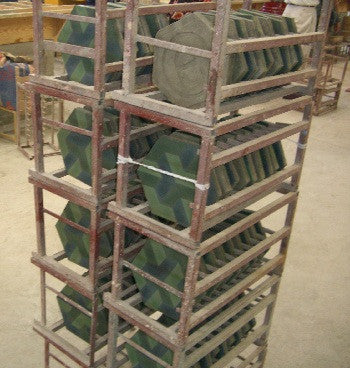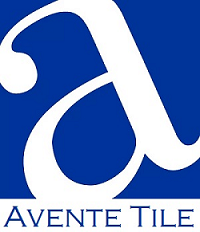Avoiding Efflorescence in Cement Tile Installations
Posted by William Buyok on
Efflorescence is a physical phenomenon that occurs with concrete in the presence of water. The discussion is slightly technical; however, it's easy to understand and should be considered required reading if have concrete tile or are considering it for an upcoming project. It is important you understand what efflorescence is, where it comes from, why it occurs and how to remove it or stop it. Efflorescence occurs with all concrete; however, the problem is primarily associated with decorated or pigmented concrete because it changes the color and appearance of the tile.
What is Efflorescence?
Efflorescence is a powdery substance or incrustation that sometimes forms on concrete surfaces like cement tiles, sidewalks or drives. It's important to remember that efflorescence is a normal physical phenomenon. It can occur with any product containing Portland cement including clay, terracotta, and concrete. It commonly looks like a white powder or salt on cement tile. The word, efflorescence, has French origins and means to flower.
Efflorescence does not usually damage the tile or cause structural problems, especially when the root of the problem is quickly addressed. However, efflorescence is pretty darn ugly to look at and certainly changes the design and color of the tile when present.

Powdery efflorescence found on Rustic Pavers used for an exterior walk
Where does Efflorescence come from?
Efflorescence occurs when when soluble salts and materials come to the surface of concrete and mortars. Ever boiled a pot dry or rinsed your car with a hose in full sun? Notice how there is salt ring or residue left? As the water leaves and evaporates, it leaves the salt behind. Efflorescence is a similar phenomenon. As cement or cement tiles dry, the lime in the cement rises to the surface with the water and reacts with carbon dioxide in the air to form calcium carbonate. In this case, a white powder or film forms on the tile's face. It's induced by low temperatures, moist conditions, condensation, rain and water. It can occur very soon after exposure to moist or cool conditions or more gradually in sub-grade concrete installations (like a subterranean parking garage).
Efflorescence does not usually damage the tile or cause structural problems, especially when the root of the problem is quickly addressed.
Because of how they are made and shipped, efflorescence may be present when cement tiles are taken out of the boxes. More commonly, it may occur right after installation especially when installed on cement subfloors.
Cement tiles are hydraulically pressed and then placed in racks. The tiles are soaked in water baths in order to achieve water saturation and guarantees proper cement hydration. Then tiles are left to dry for 10 days and cure before shipping.

Racked Cement Tiles Await a Water Bath to Cure the Cement

Water Bath for Curing Cement Tiles
Efflorescence like I described above is usually referred to as powdery efflorescence and ordinary encountered. Powdery efflorescence is common on unsealed exterior tile walks, unsealed interior tiles in damp or wet locations, and will often be seen when newly manufactured cement tile are pulled from the box after being stored in cool, humid climates prior to installation.

Powdery efflorescence appears as a white powder on this unsealed tile walk
There are two types of efflorescence. The other type is called crystalline efflorescence. When powdery efflorescence goes through cycles of being deposited on the surface it can form larger crystals that strongly bond to the surface. The build up of crystals is caused by microscopic water flow, called capillary water flow, into the tile. The solid tile pulls the water up to the surface like a sponge. The water evaporates and leaves the salts behind. You must stop the water flow through the the concrete to stop the build of salts as the water leaves the surface of the concrete. If there is no water source, to create capillary water flow through the tile, efflorescence can't occur. This type of efflorescence is more common with concrete foundations, poured-in-place concrete, or concrete in damp or wet applications that have not been installed with a proper vapor barrier.
If there is no water source, to create capillary water flow through the tile, efflorescence can't occur.
Crystalline efflorescence is much more difficult to remove because of the bond between the salts and the porous concrete tile body. Different cleaning treatments are designed to work on a specific type of efflorescence. Remember that crystalline efflorescence can be removed by cleaning; but, you must stop the capillary water flow through the tile or it will soon re-appear.
How do I Prevent or Stop Efflorescence?
In laying cement floor tiles, be sure to install over a stable cured cement subfloor. It is critical that the cement base be completely cured before laying floor tiles. If the concrete subfloor is not, moisture may seep up into the tiles and cause efflorescence to appear on the tile surface. If there is no water source, to create capillary water flow through the tile, efflorescence can't occur. An ounce of prevention is always better than a pound of cure.
How do I Remove Efflorescence?
Efflorescence that appears on the tile before installation will generally come off during the installation process. You may be able to sand small localized areas. Use a piece of wet sandpaper (200 grit), wet the tile, and sand the area.
When efflorescence occurs after installation, first try to remove the efflorescence by cleaning the tiles thoroughly. Use a floor polisher with green pad, a neutral soap and plentiful water. Remember, you'll need to let the tiles thoroughly dry to confirm the efflorescence has been removed and stopped.
The use of a penetrating sealer should stop efflorescence from resurfacing. So if you are still having a problem area, this is the next step. Always test the reaction of the sealer in an inconspicuous area prior to applying to the entire floor. Make sure to use a high quality penetrating sealer and follow our Sealing Recommendations for Cement Tile.
Additionally, efflorescence cleaners are available. I have no experience with the products so make sure to test them on a loose tile or hidden area to ensure the results. Carefully follow the directions provided by the manufacturer and avoid any acid-based products that will damage concrete tile.
Since you understand efflorescence, you should feel confident that you can proceed with your cement tile project. Let's have some fun and get started with the design. The best place to start is to download our Cement Tile Buying Guide and then head over to our carefully curated cement tile information center for more information. Just click the links below or contact us.
Share this post
- Tags: Cement Tile, Efflorescence

